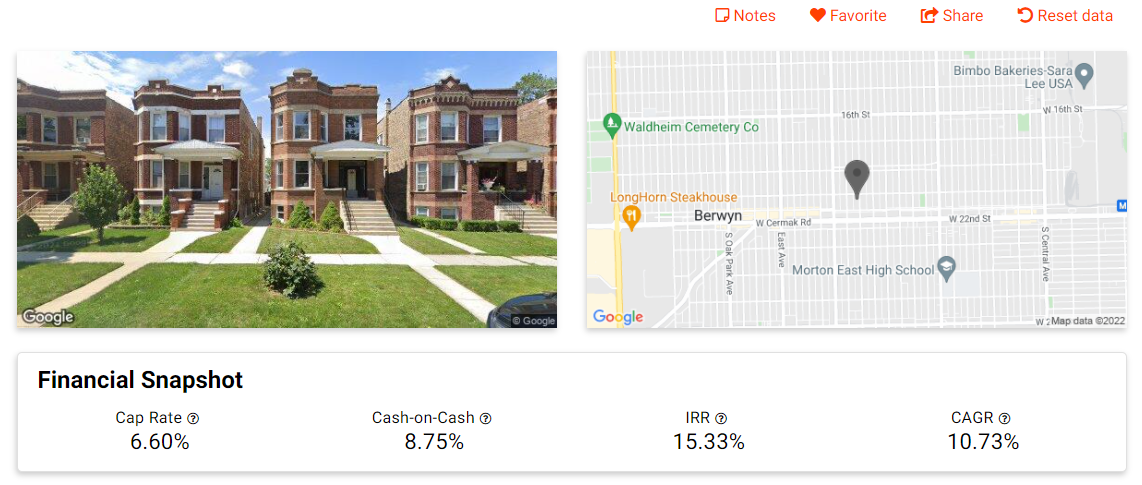Invest confidently in real estate
Invest confidently in real estate

Cash-on-Cash return is a real estate metric used to evaluate the earnings on a real estate investment relative to the cash invested in that property. This metric is an easy way to measure profitability in a rental property and is a quick way to evaluate the potential earnings per year of your real estate investment. In this article you'll learn the definition of cash-on-cash return, how cash-on-cash return is calculated, and how to know if the cash-on-cash return rate is good or bad.
Cash-on-Cash (CoC) return is a critical metric for real estate investors that want to know the expected annual returns for the investment property. It specifically compares pre-tax earnings to the amount of cash invested in a property. CoC return is sometimes referred to as the yield.
Unlike the cap rate, which does not include any debt service, CoC return can be used if there is financing, and looks specifically at the cash invested as a down payment. If there is no financing, CoC return, and the cap rate will be the same.
Like other individual metrics, you'll want to do a full property analysis to make sure it meets your investing strategy. Consider all the essential metrics while you are doing your evaluation of the property.
CoC return uses two values for its formula: annual net operating income (NOI) and total cash invested to acquire the property. Annual net operating income is the property’s annual pre-tax cash flow. It is the income from the property minus all expenses including any mortgage payments. The total cash invested includes acquisition costs like down payment and closing costs. It does not include any initial rehab costs as those are considered costs after acquisition – those expenses are part of the first year of ownership and would be included in a calculation of total return on investment.
The formula for calculating CoC return is:
CoC Return = annual NOI / cash invested
Investors have a variety of ways to hone their investing strategy to maximize the CoC return. Financing a property is a straightforward way to get leverage from your cash – you will have less cash invested, but you will have the expense of the mortgage payment including interest on the loan. Some investors also consider increasing NOI by increasing rental income. In both cases, this will have different impact on the CoC return.
In this example, consider a three-unit property that costs $442,000 and each unit rents for $1,300/month:
$32,781 pre-tax cash flows / $442,000 cash invested (full purchase price) = 7.4%
If you finance the property, you will have less cash flow because of the expense of the mortgage payment, but the cash invested will be much less. In this case, the CoC return is less, but the amount of cash invested is also much less. In this example, the property is financed for 30 years at 5% with 25% cash down:
$11,552 pre-tax cash flows / $110,000 cash invested = 10.48%
If you finance an investment property and then subsequently invest future profits in some improvements so you can increase rental income, you may see CoC return increase in future years. In this case, the CoC return for the same property is higher after a rent increase to $1,500/month:
$18,192 pre-tax cash flows / $110,000 cash invested = 16.54%
Investors sometimes wonder if return on investment (ROI) is the same as CoC return. In short, no. Return on investment is a metric to measure the profitability of the entire investment over the lifetime of the investment. This will include potential gains on equity, the money spent on debt service, and costs like maintenance or repairs over time. CoC return is specifically focused on the return on the cash you invest when you acquire the investment.
CoC return is different from cash flow. Cash flow is a dollar value showing the actual amount of cash an investment will generate as profit or loss. Positive cash flow, your passive income, will also indicate the money available in your bank account after all expenses have been paid. CoC return is expressed as a percentage value relative to the amount of cash invested to acquire the property. It is an indication of the rate of return on your cash invested.
Investors often wonder if the CoC return for a particular property is good or bad. Of course, it depends. There are many factors that will help you determine if the CoC return is good or bad. You will want to compare the rate to other properties you are considering. You’ll also want to consider the return relative to other non-real estate investments. Like other important metrics for real estate investors, you’ll want to consider CoC return along with the other essential metrics for the properties you are considering.
Cash-on-cash return is a simple way to understand the rate of return on the cash you’re investing in a property. You can use it to compare different properties, or to compare an investment property to the cash you’d otherwise invest in some other non-real estate investment. It is part of the comprehensive analysis you’ll get with Padvest’s property research report.

In the financial snapshot of the report, you’ll see cap rate, Cash-on-Cash return, internal rate of return (IRR) and compound annual growth rate (CAGR) so you can quickly get an assessment of the property you’re considering. Check out Padvest Research and learn how to get free evaluation reports so you can make quick, confident decisions on your real estate investments.